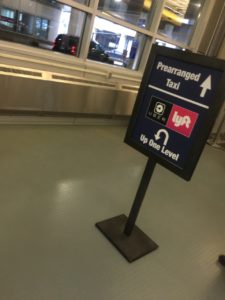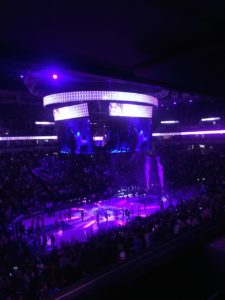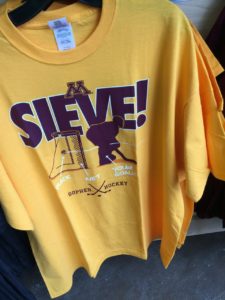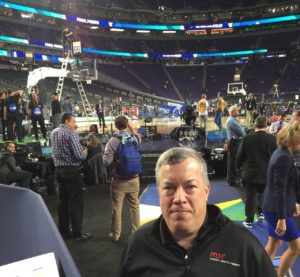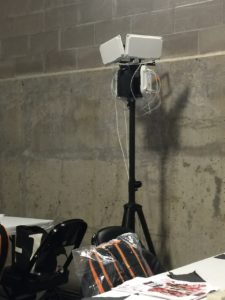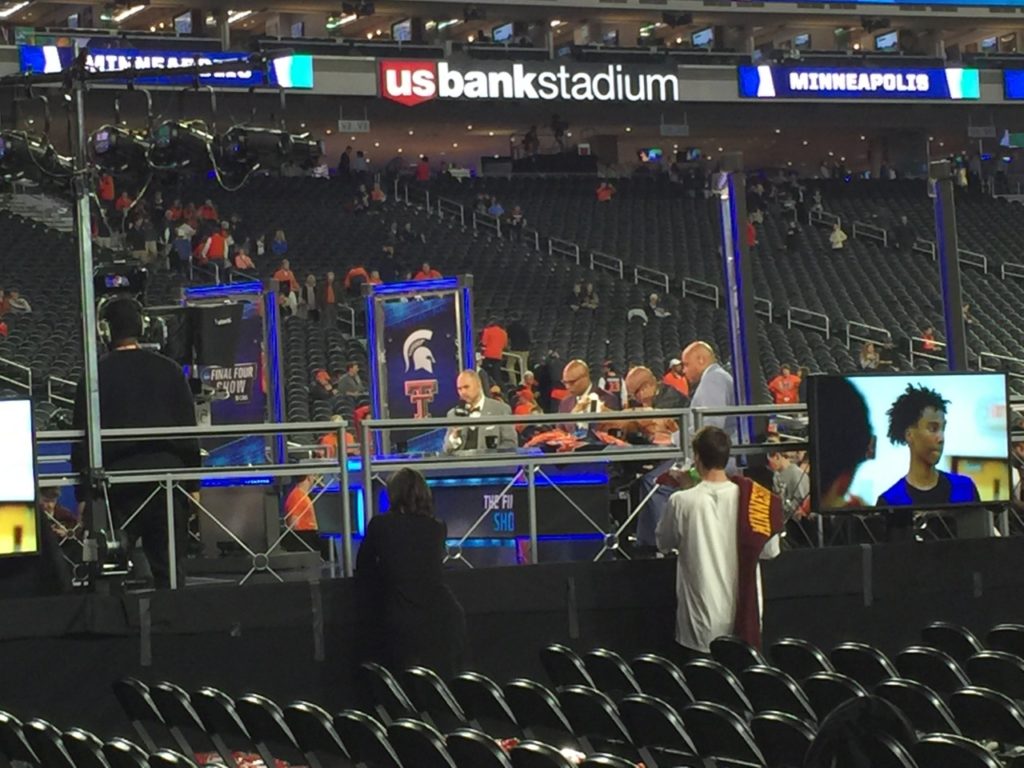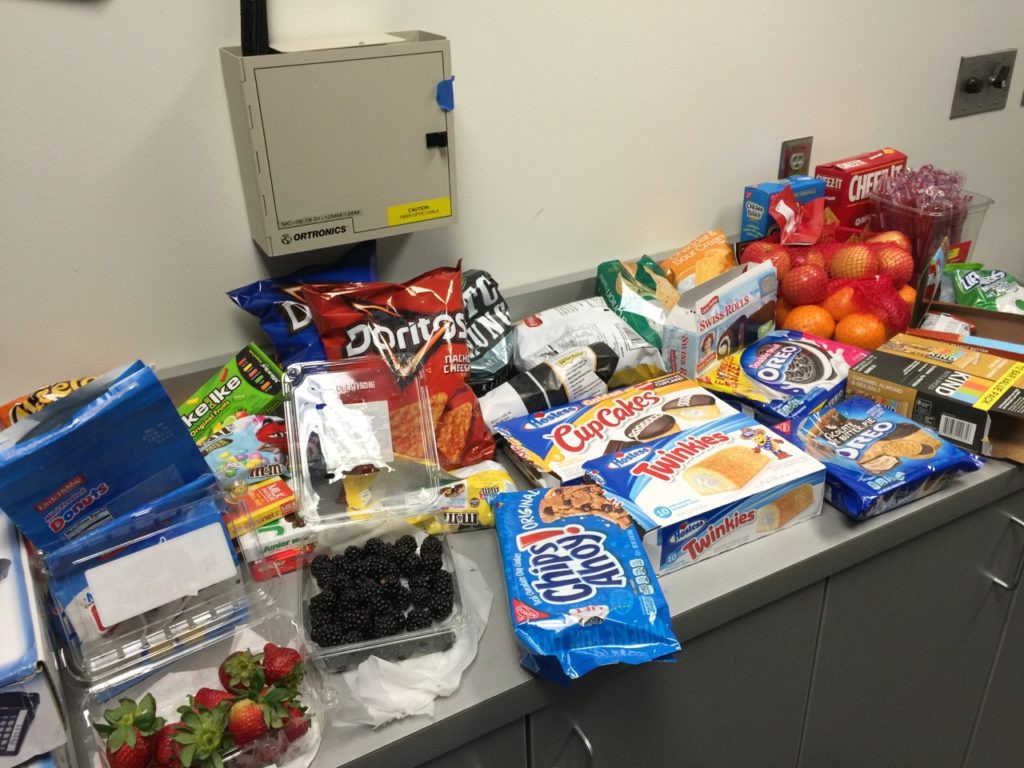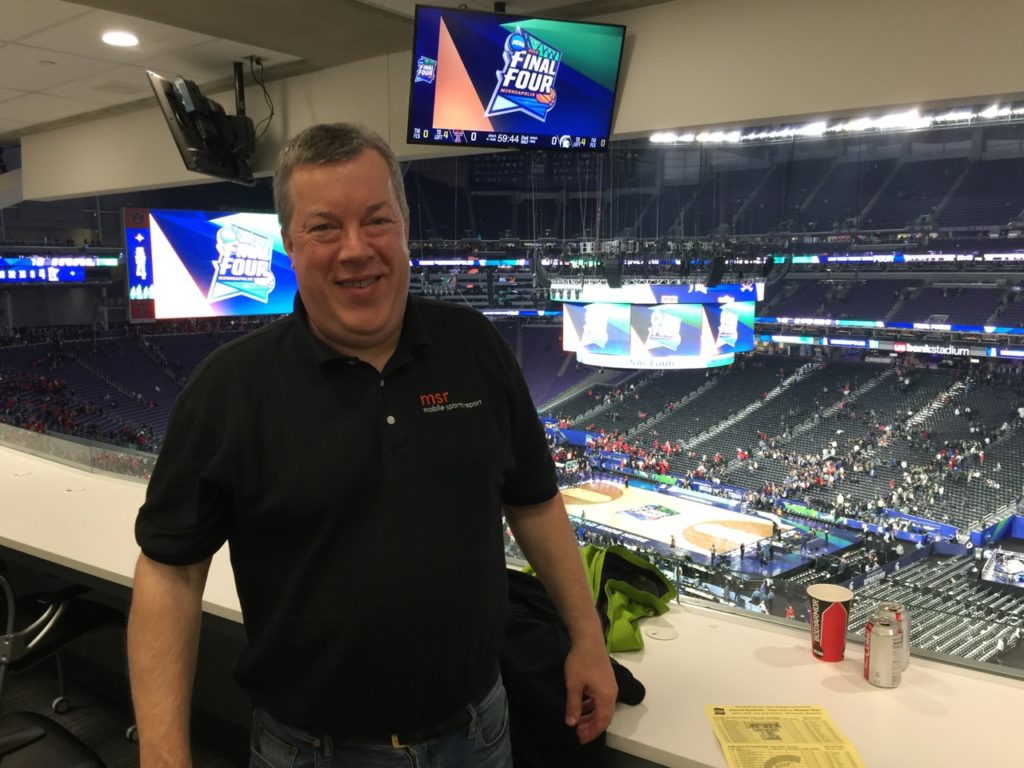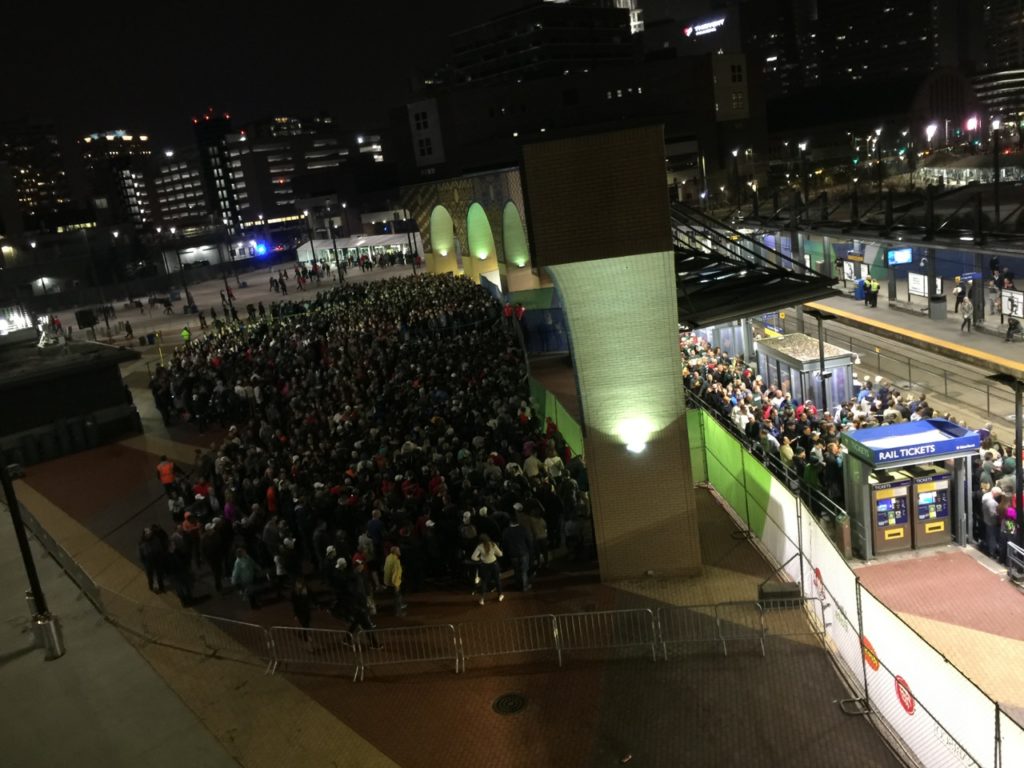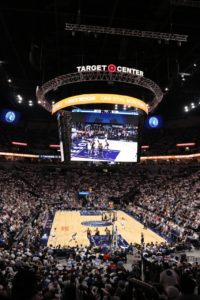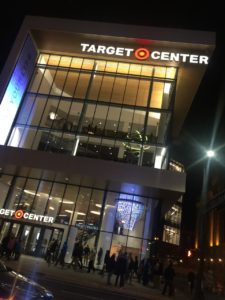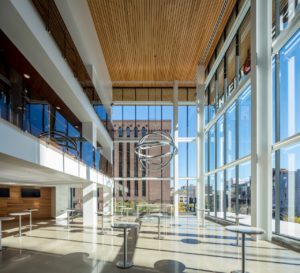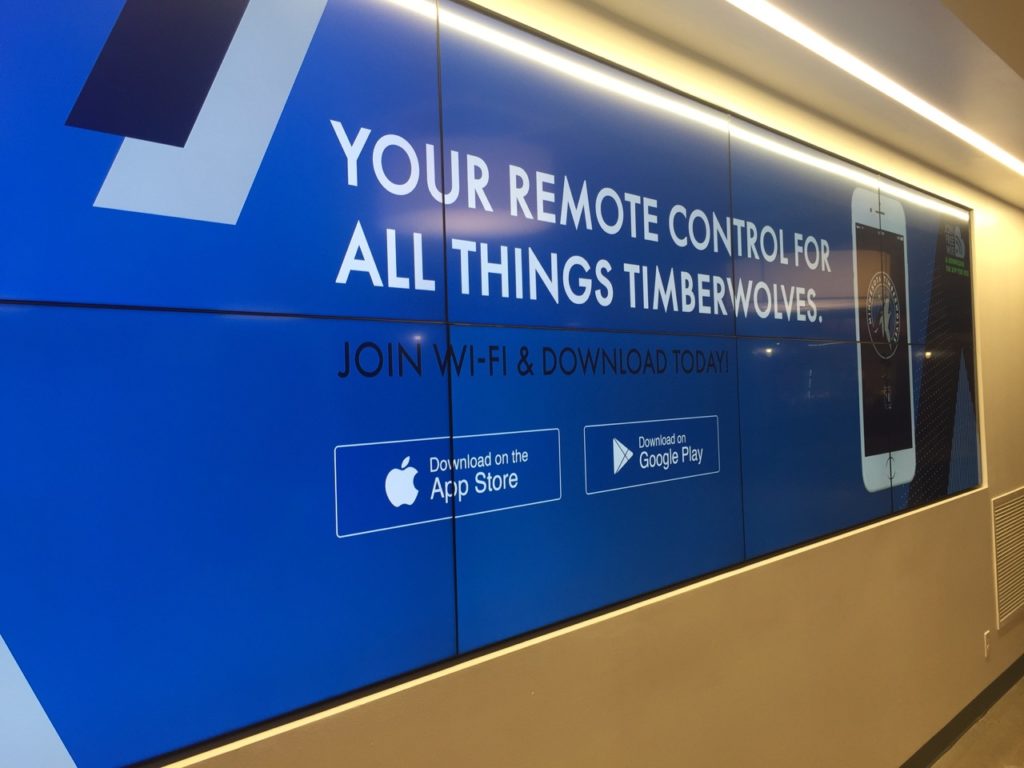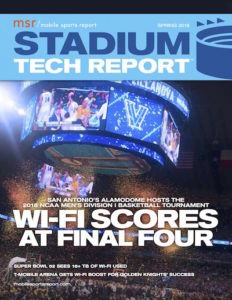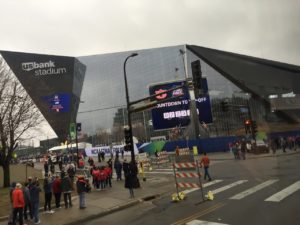
On the press bus to the stadium for the semifinals. Credit all photos: Paul Kapustka, MSR (click on any picture for a larger image)
Friday, April 5, 2019: Getting to the Final Four, and a Prince tribute
If there was a recurring personal theme to my Final Four trip last year it was: dealing with my hip. After almost a year of putting up with various hip-related pains in November of 2018 my situation went “off the cliff” as one doctor said, rendering me unable to do much walking or any other activity. A subsequent MRI revealed that I had almost zero cartilage left in my right hip, which meant — after other MRIs confirmed it wasn’t a problem with my back, on which I had surgery 10 years ago — that I needed a hip replacement. The good news? It would turn out to be the most pain-free major surgery I’d ever had or heard of. It was done in an outpatient procedure and I was walking without crutches five days later.
The bad news? The surgery didn’t happen until late May. In early April I was still hobbling around in a sidewinder motion, slapping lidocaine patches on and taking anti-inflammatories to make it through each day. But with the downtime associated with the surgery ahead, I had to get enough stories in my notebook to fill our spring issues — so off to Minneapolis I went.
I can’t thank the NCAA folks enough for granting MSR a credential (they had also done so the previous year) for the Final Four. There is nothing like being on site for an actual game to see how the networks and other technologies perform. While sometimes vendors and teams are able to find us some kind of pass to get stadium access, at the biggest events having a standard media credential just makes life easier for all involved. The trick is, convincing the powers that be that MSR’s coverage is beneficial to a sports audience. (Someday, Super Bowl, someday.)After landing at MSP airport I got an almost instant dose of what is generally called “Minnesota Nice.” I had just started ambling up the concourse toward baggage claim when a nice gent pulled up beside me in one of those golf-cart things and said, “I can spot a bum hip a mile away. Get in!”
One of the numerous airport volunteers, the “Minneapolis ambassador” spared me about 15 minutes of pain-walking, a break I welcomed. “When’s your surgery?” he asked. I told him and he replied, “you’ll kick yourself after it’s over for waiting so long. But you’ll love it.” Correct on all counts. As I got out of the cart to go down to baggage claim, a local cheerleading group was doing their moves in the airport’s main atrium. I did a quick check of the Wi-Fi (good signal) and got my bag.
The other nice thing about a real media credential is having a real room at one of the official media hotels. You do pay for it — and are required to pay for four nights no matter how many nights you are actually there — but it’s worth it. Even though our Marriott (sports writers practically live in Marriotts) was close enough to walk to the stadium (about a half-mile or so), in my condition I needed the saturation of shuttles and free rides that are de rigeur for any big event like the Final Four. After checking in I took one of the shuttles provided by Buick (NCAA sponsor) over to the stadium to get my credential and lucked out as there was no line at all, allowing me to get my badge in just a few minutes’ time.
Instead of trying to find where the shuttles picked up I tapped my “insider knowledge” of Minneapolis (which I had visited several times over the past couple years) and took the light rail from right outside U.S. Bank Stadium back toward the hotel — there was a station just about a block away. Walking back I noticed one other great maybe-not-a-coincidence about the location of the media hotel I was in: There was not one, but two local brewpubs on the separate street corners from the hotel entrance. And yes, over the weekend I visited them both. Good local beer and good pub-fare food. And of course, friendly people working there.As if I wasn’t going to see enough basketball, on Friday night I went to the Target Center to watch the Timberwolves play the Miami Heat. It was a great way to relax into the weekend, and for a change I didn’t even go around and test the Wi-Fi (we had done a profile of the arena’s new technology the year before). And the game was one of the several “Prince tribute” events the Wolves had last year, where they wore purple jerseys and a band played Prince tunes at halftime. Very cool, very Minneapolis.
Saturday, April 6: Semifinals and Sally’s Saloon
With the semifinal games not starting until early evening, there was time to kill — so I hopped on the light rail again and crossed the Mississippi River over to the University of Minnesota area, where I had a late lunch at Sally’s Saloon, one of the several iconic U of Minn watering holes. Since it was rainy and chilly out I went with a good bowl of chicken soup while I watched the end of the inaugural women’s tournament at Augusta National — what a great way to get psyched for the Masters. And what great golf! Would love to come back and tip one at Sally’s pre- or post-football game. It just has that perfect college-bar feel.
After the local-scene interlude I went back to the hotel and boarded an early bus to the stadium, more to get the lay of the land than to file any stories. The great thing about my work as opposed to most writers there is that I wasn’t on deadline — my profiles wouldn’t appear until our June issue. After finding my assigned seat — way back in the back row of the press area behind one of the hoops — I went down to the floor to walk around before it got closed off. It’s cool to see the setup up close, the raised playing court, the band areas and wander right up to the NBA on TNT set in one corner, where Ernie, the Jet and Chuck (no Shaq that day) were holding court, live.The terrible sight lines from my seat were not an issue — after all, my work was not to watch the game but to wander the stadium as the games went on, testing the wireless networks while the fans gave them the ultimate selfie workout. It’s just nice to have a place to rest (especially if your hip hurts), so it’s a nice perk. As it turns out, my seating arrangement was about to get much better (for me) in short time.
I did make it back to the “press working room,” a cordoned-off wide space in the bowels of the building. Think: concrete floors, hanging-drape walls, plastic row tables and folding chairs. Those are the typical conditions for big-time sports writers, photogs, bloggers and others at the big events. With something like 2,000 credentialed media, a standard press box won’t do.
While spartan, the press rooms do have everything you really need to get the job done: Nearby access to interviews (a separate stage where they bring players and coaches in), power strips everywhere for laptops and phones, and serious Wi-Fi coverage in the form of temporary antennas on poles throughout the room. There’s also a basic but efficient food and drink service, which I avoided other than getting sodas and coffee. I’d just rather get stadium food instead of steam-tray stuff, to get a sense of the venue’s “flavor” if you will. Plus as I said earlier I’m not on deadline and usually not sitting in a seat so it’s easier to just grab something as I walk around.I next went to find my networking types and was directed to the football press box, where David Kingsbury, director of IT for the stadium, had set up the NOC HQ in what looked like a coaches’ box. Like any good general David had set up his troops for success with a wide array of healthy and not-so-healthy snacks, which I was allowed to partake in. I did enjoy my fair share of Kind bars over the weekend, and was reminded (after a taste test) just how tooth-twistingly sweet a Twinkie is. (Rejected after one bite.)
While waiting for David and his team to find some time for a quick interview I noticed that the football press box was completely empty — and thought, why not set up here as a base for my stuff and to watch the games when I needed a break? For someone who wanted to spend the day roving around the venue, the football press box was a much better base location than my official press seat (which involved a series of tunnels and stairs to get to). Plus it had comfy office-chair type seating and lots of room to spread out. Sure the court was far away, but all the multiple TVs in the press box were live, giving you as good a view as anyone’s living room couch.
Sometime during the night the press folks let the rest of the media know they could sit in the football press box on a first-come, first-serve basis, and while some others eventually joined me the place never got full. While there was none of the food or beverage service usually in place for Vikings games, the added bonus of the football press box was that it has its own restrooms — something not available near the courtside seats. And in the temporary official press room, the facilites were a trucked-in port-a-potty trailer.Since I had only made it to the final game of last year’s championship I was interested to see what the crowds would be like for the semifinals — would the second game fans skip the opener and arrive after halftime? The answer — not a chance. If you’re at the Final Four, you do the Final Four, and the stadium was packed by tipoff of game 1. And for the first time, the Final Four was allowing alcohol sales, and beer was very popular at the many concession stands and kiosks around the venue. AmpThink, which in addition to having done the regular stadium Wi-Fi had also constructed a temporary Wi-Fi network for the additional courtside seats, put all the switches it used under the stands inside waterproof cases — in part to protect from inevitable beer spills.
Over the course of the first game, I wore myself out completely, overdoing it a bit with stadium laps to see if the network held up everywhere, from the courtside seats to the highest seats up in the rafters. What impressed me was how many people were really into the games, even from far-away seats. I tried to find the perfect picture from behind, of a fan using a phone to record the action, but truthfully my opportunities were few and far between, as most people really paid attention to the action on the court. One thing that surprised me was how fast the Final Four gear sold out: There was one hat I thought was really neat, and thought “well, I’ll get one Monday.” Rookie move. By the second game Saturday, there were almost no hats at all of any kind available, with the design I wanted long gone. Next time, I’ll buy any swag on Friday at the media hotel, where there was a pop-up stand for one day only.
In between games I retreated to my football press box seat, and found some time to interview David Kingsbury and his staff about not just the Wi-Fi and DAS but the displays as well, including the temporary centerhung board which was pretty amazing for a once-only apparatus. In addition to multiple screens it also had the capability to project images onto the court itself, an extra kind of screen that really brought pregame ceremonies to life.
With the games finally over and Monday’s championship between Virginia and Texas Tech set, I walked out with the AmpThink team, skipping the masses that formed a huge line at the light rail station outside the stadium. However, we didn’t do much better trying to hail an Uber or Lyft, having to walk nine blocks away from the stadium before we could get clear enough from crowds to get an SUV driver to pick up all seven of us. A late-night dinner at an excellent brewpub capped a great night of hoops and networking. More later this weekend on the rest of the weekend, including trips to a soccer stadium and the Mall of America!
Here’s the link to part 2 of the story.
More photos below!
Up close and personal with the NBA on TNT crew
The good, bad and the ugly at the NOC HQ snack table
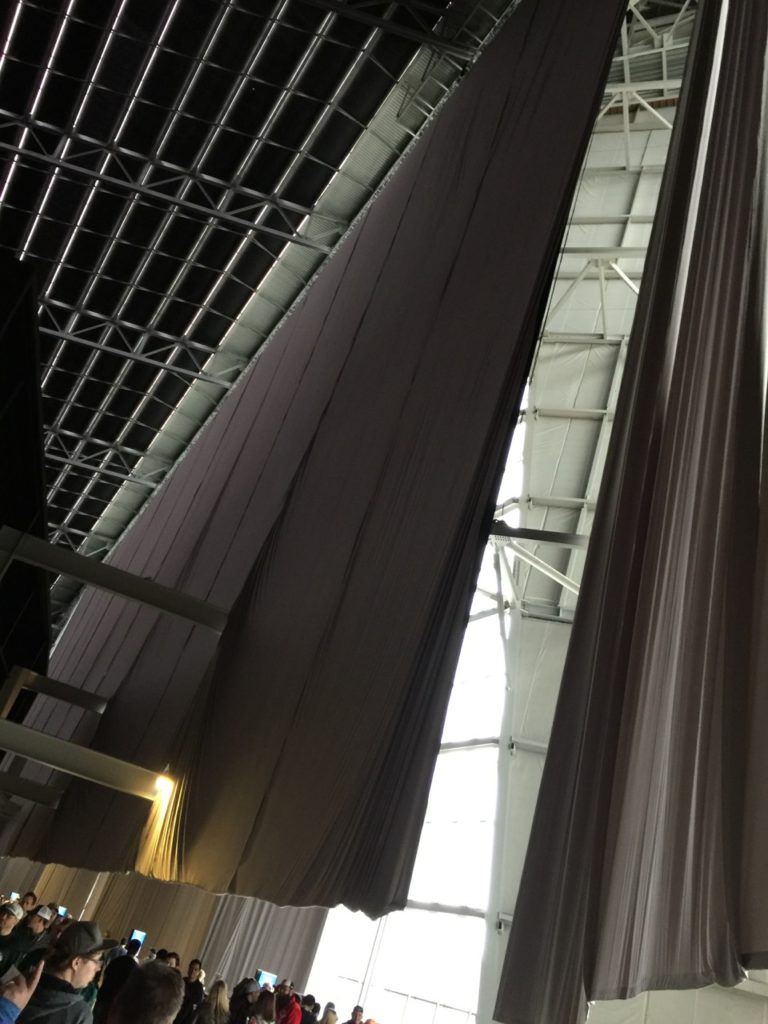
Some of the $5 million in curtains U.S. Bank Stadium had to set up to keep the light out
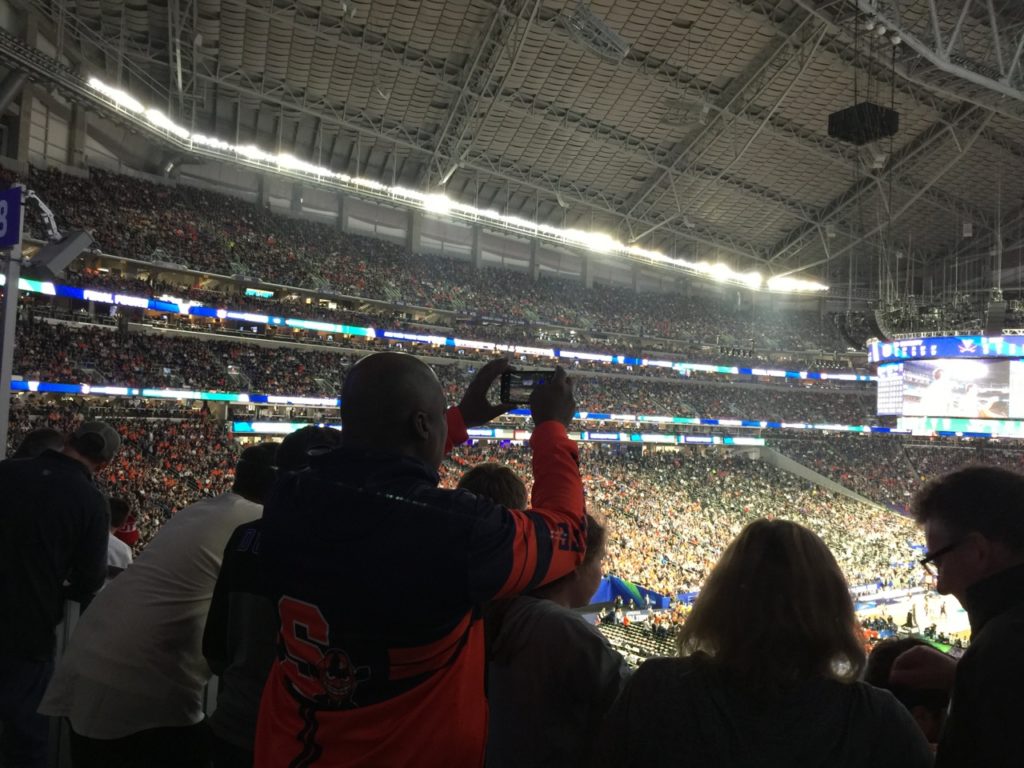
Kept trying to find the perfect ‘fan with a camera’ shot. Bonus geek points if you can spot the MatSing ball antennas
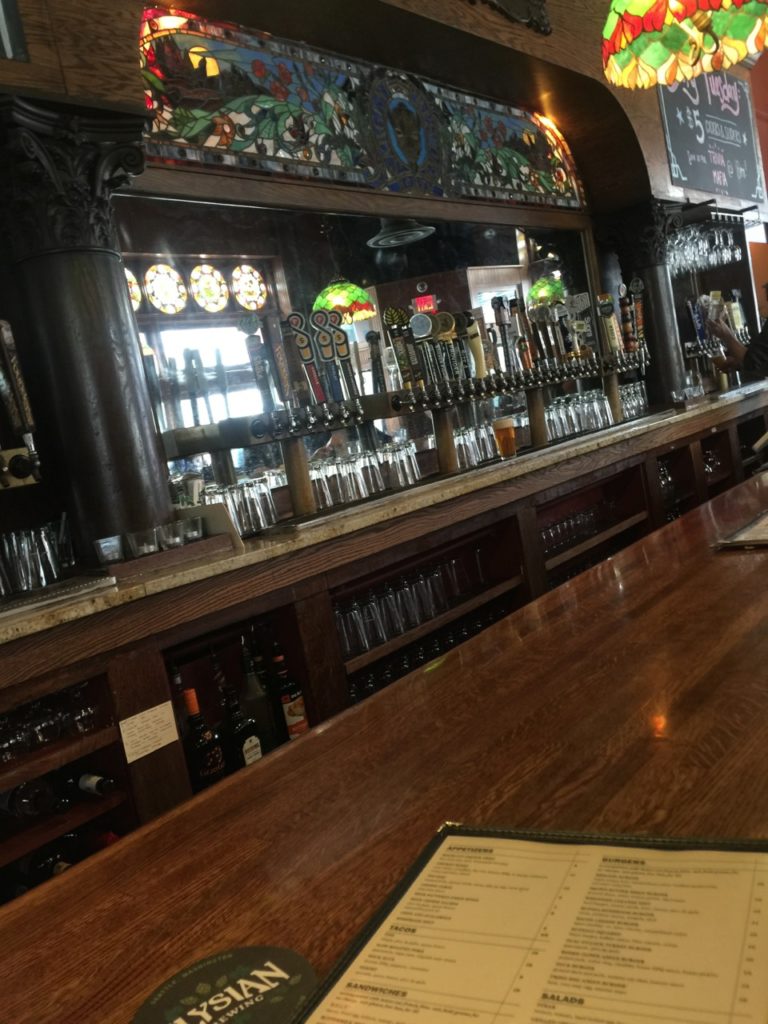
Republic, one of the two brewpubs on either side of the media hotel
The crush at the light rail station after the semifinals
